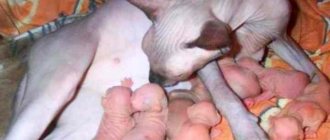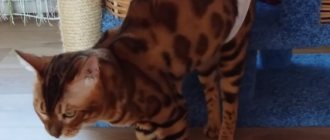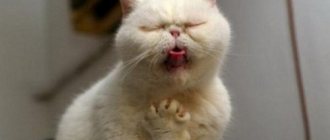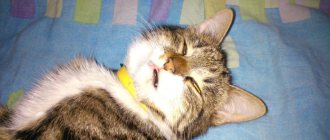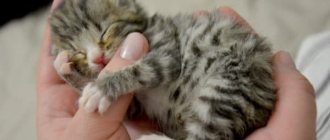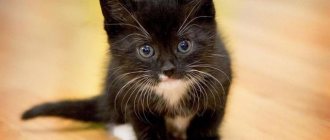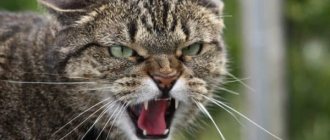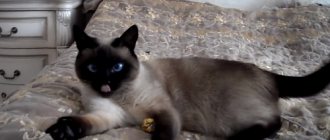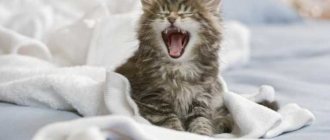- Can a cat get pregnant during lactation?
- Why is contact between a nursing cat and a cat harmful?
- How to prevent pregnancy in a nursing cat
- What to do if a nursing cat becomes pregnant
The pregnancy period of a cat and the birth of offspring is a difficult time not only for the pet itself, but also for its owner. It is not surprising that after the birth of baby kittens, the owner hopes to take a little break from the cat’s amorous affairs and the subsequent quirks of her “interesting” position. But you shouldn’t relax, because a cat can become pregnant while feeding
, that is, soon after childbirth. Let's look further at why this might happen.
How to avoid conception during lactation
Contraceptives will help avoid unwanted conception. Veterinarians do not recommend abusing oral medications. There is a risk of the animal contracting pyometra. Birth control pills like Contrasex are contraindicated in nursing cats.
You can control the onset of estrus by using the injectable contraceptive "Covinan". The hormonal drug will relieve the animal from estrus for 6 months.
To reduce sexual heat, it is preferable to give a nursing cat herbal medicines with a sedative effect (Cat Bayun, Fitex).
This is interesting: How to inject Gamavit into a cat?
How to prevent pregnancy in a nursing cat
If the cat does not participate in breeding, and its offspring are not of particular financial interest to the owner, it is advisable to sterilize the animal. The best time for this is after 6 months - 1 year. Theoretically, it is possible to perform surgery on a nursing mother cat to prevent her from becoming pregnant again. If sterilization is undesirable, you can give your pet sedative medications based on medicinal herbs (such as “Cat Bayun”, “Fitex”). You also need to monitor your nursing cat, especially if she goes into heat soon after pregnancy. That is, it is necessary to exclude contacts between the female pet and cats.
You should not use alcohol tincture or valerian tablets as a natural sedative. This remedy for pets is a drug that puts them in a state of extreme excitement. That is, a cat who has started to heat, after a small amount of valerian solution or tablets, will have one goal - to quickly connect with the cat. The existing kittens will naturally go to the side.
Also, hormonal drugs that suppress sexual desire are also extremely undesirable for calming a nursing pet. Products of this type (“Sex barrier”, “Contrasex”, etc.) have a lot of contraindications, and they cannot be used by cats during lactation.
Intervals between the birth of kittens and feeding
Veterinarians recommend an interval of at least 4 months between the birth of kittens and their feeding
There is no definite opinion on what the number of births a cat should have. For owners of purebred cats (including Scottish Folds), veterinarians recommend sticking to no more than 3 lambings in 2 years . It is necessary that the interval between the birth of kittens and their feeding be at least 4 months . If the pause is longer, even better. It will allow the cat to restore its health after the period of pregnancy, childbirth and feeding. The body (when fully recovered) will be able to get stronger before the upcoming next birth.
If the owner does not have the goal of breeding kittens on a professional level, it is wiser to sterilize the animal, since each birth process greatly depletes the female’s body.
When there are contraindications to sterilization, veterinarians prescribe hormonal abortion.
What to do if the kittens are small and the cat is pregnant again?
Knowing how long it takes for a cat to become pregnant after giving birth, many owners nevertheless find themselves faced with the unpleasant fact that a nursing cat is expecting another offspring. This situation most often arises if she had access to the street or if there is an unsterilized cat in the house. You can solve the problem in the following ways:
- Sterilize the animal. If a cat does not have breeding value, it is wiser not to produce outbred offspring and not to exhaust the pet’s body with endless childbirth.
- Hormonal abortion. It is used by veterinary specialists in cases where there are contraindications to sterilization. In this case, different hormonal drugs are used depending on the stage of pregnancy.
The owner of a furry beauty should have an idea that a nursing cat can also come into heat. The task of a responsible breeder and simply a caring owner is to prevent the animal from becoming pregnant immediately after birth. Compliance with the terms of the rehabilitation period for a purebred cat will help maintain health and produce full-fledged young animals.
Types of contraception for cats. Cats are the most prolific pets. In a year, a female can become pregnant up to 6 times, giving birth to 7 - 8 kittens. . When can a cat become pregnant after giving birth?
When can a cat become pregnant after giving birth? How to find a missing cat if it is lost on the street. Marina (content manager).
After mating a pet, the owner wants to know how long pregnancy lasts in cats. . 2 - 3 weeks before giving birth, the nesting instinct awakens in a domestic cat.
How long after giving birth can you plan to conceive?
To understand how many times a year cats give birth, it is necessary to take into account that after giving birth, the next heat occurs 1.5-2 months later.
What to feed a cat after giving birth: proper nutrition and care
It is believed that at this moment the animal can become pregnant. If there is no control over mating, cats can produce offspring 2-5 times a year. However, frequent pregnancies are harmful to the health of the pet, since the body does not have time to recover and exhaustion occurs.
There is no need to plan for conception when the cat is busy feeding past offspring. Otherwise, babies will not receive enough microelements.
Important! Ideally, there should be 6 to 12 months between matings.
This period ensures complete restoration of the cat’s physical condition, as well as hormonal levels. For example, British cats are mated no more than 3 times every 2 years.
What frequency of births can be considered optimal?
Against the backdrop of all of the above, a completely logical question may arise: “How often can cats give birth in order to avoid the problems described above?” It is interesting that among professional breeders and veterinarians there is still no consensus on this. However, many cat owners who professionally breed them believe that the animal should not give birth more than twice a year.
But! And in this case, everything is not so simple. There are many studies proving that such a regime (even if it is very different from the natural frequency of reproduction) greatly depletes the animal’s body, worsening the health of its reproductive system by an order of magnitude. Consequently, such a cat lives less and brings into the world a weakened and non-viable offspring.
Thus, today many veterinarians and the most responsible breeders believe that in three years a cat should produce no more than two litters
(i.e. once every year and a half). As a last resort, childbirth is allowed every year, but not more often. In this case, the cat manages to feed all her kittens from previous births without interference, and her body is fully restored and rests accordingly. The health of your pet, as well as the health of all her future kittens, remains safe. In addition, experienced breeders believe that cats over seven years old should generally be sterilized, since they are no longer worth breeding. The fact is that at this age the likelihood of kittens being born with congenital malformations and deformities increases sharply.
Let's summarize. Unfortunately, after giving birth, your pet can quickly become pregnant again.
To prevent this from happening, isolate her while feeding the kittens and immediately consult a doctor if you notice signs of heat.
Cat pregnancy and the subsequent birth are complex and not easy for the furry pet, as well as for its owner. Of course, as soon as cute fluffy kittens are born, a person dreams of a break - he intends to take a break from the mating rush of the cat and her quirks when she was pregnant. But it’s too early to relax, because a cat can become pregnant very soon after giving birth, breastfeeding squeaking blind kittens. How this can happen will be discussed below.
Natural food products
Products are chosen fresh, rich in proteins, calcium, carbohydrates and beneficial elements.
Among them:
- boiled lean meat: chicken, beef, rabbit, turkey, veal;
- vegetables: beets, pumpkin, cauliflower, carrots, zucchini;
- cottage cheese, curdled milk, natural yoghurts, biokefir;
- cereals: buckwheat, oatmeal, sprouted wheat grains.
To reduce the risk of developing constipation due to intestinal problems, add to the main diet:
- low-fat broths in which meat was cooked;
- warm milk (in small quantities);
- 3 – 4 drops of flaxseed, olive, sesame oil (added to food);
- boiled beets or puree from them;
- young shoots of oats, wheat, barley.
Approximate diet
In the second week of pregnancy, the cat’s appetite increases, therefore the amount of food is increased by 10% of the previous volume, from the second month - by 50%. In the last weeks before childbirth, appetite decreases, it is recommended to reduce portions, and the number of feedings is calculated based on the needs of the expectant mother. An adult animal needs 180-200 grams per day to be satisfied.
Useful knowledge for the owner: when can a cat become pregnant after giving birth?
After the birth of kittens from their beloved pet, owners often think about when a cat can become pregnant after giving birth. Experienced breeders know that after the next lambing there must be a rehabilitation period, during which the animal will regain strength, get stronger after pregnancy and childbirth, and feed and raise its offspring. It is useful for every owner of a furry beauty to have such information.
Read in this article
This is interesting: Can cats have valerian?
conclusions
People who own cats should be aware that after giving birth the cat may go into heat. If you follow the deadlines for the period intended for rehabilitation, this will not only help preserve the health of the feline representative, but also wait for full-fledged offspring in the form of healthy kittens.
Thus, the conclusion is this: a nursing cat, and the owners need to draw certain conclusions: allow pregnancy or prevent it.
When a fluffy, uncastrated young beauty lives in the house, sooner or later the owner is puzzled by the question of what time the cat can become pregnant. Knowledge in the field of physiology, understanding of the characteristics of sexual behavior, and the nuances of reproduction will help you competently approach the problem of keeping and breeding a pet.
A cat can become pregnant while nursing - that's a fact!
The kittens have already grown up, a nursing cat can already begin to flock to new ones!
This opinion is due to the fact that prolactin, which is a stimulator of milk production, blocks the production of those hormones that are responsible for ovulation.
As for representatives of the cat family, this rule almost does not work, since during sexual intercourse they may ovulate. Thus, estrus and, as a consequence, pregnancy can also occur in a nursing “lady”.
This circumstance must be taken into account and the “mother cat” must be protected from mating immediately after giving birth, that is, the male must be driven away. Similarly, it was necessary to drive away the male during pregnancy.
A rehabilitation period is necessary for an animal that has just given birth. Otherwise, negative consequences for her fragile body .
When can a nursing cat start “walking”?
We need even more kittens. Let’s finish feeding and go “cat walking”!
This is of great interest to the owners of creatures called cats. According to statistics, a furry pet may be ready for a “sexual date” a couple of months after giving birth.
This is a normal pause for those females whose hormones are fine. It must be taken into account that each individual is individual.
If there is a failure in the hormonal system, the consequence will be an increase in the animal’s sexual desire immediately after birth. This will cause the owner a lot of trouble, since the pet:
- will begin to forget that she should take care, first of all, of the kittens; will not show appetite; will feed the babies less, as the volume of milk produced will decrease; will begin to look for ways to escape from the premises; will demonstrate signs of sexual desire more actively.
The owner of the “unlucky mother” will have to take on additional responsibilities:
- observe the complex behavior of the female; do not allow the cat to appear near her; take care of and feed baby kittens (if they don’t have enough mother’s milk).
What to do if a nursing cat asks for a cat?
If a nursing cat asks for a cat, you need to give a herbal-based sedative
As soon as a nursing cat begins to walk after giving birth, something urgently needs to be done to reduce the animal’s expression of sexual desire. It is advisable to purchase plant-based sedatives .
These tablets should not be given to a nursing cat.
Hormonal drugs such as “ Stop-barrier” and “Contra-sex” should not be given to cats during the feeding period .
The use of hormones against the background of their own actions can provoke the appearance of cancer.
Drugs to protect against pregnancy
Pregnancy can be prevented with pills or injections.
Injections stop estrus for a period of six months to a year. They must be administered before the cat asks for it.
Important! Any medical procedures must be carried out under the supervision of a veterinarian.
The advantage of the injections is that the ability to become pregnant is only blocked and after a while, the pet will be able to become a mother again. Such drugs are easy to get at a pet store.
Despite the positive aspects, injections can cause side effects, especially in animals older than 5 years.
Popular products in this category include:
- Depot Promon. This drug blocks the onset of estrus by acting on the brain centers. As a result, hormone production decreases and ovulation does not occur.
- Covinan - eliminates estrus for a period of 4 to 6 months. You should not waste your time with this drug, as it will not be able to protect against pregnancy if it is administered late. The injection is given before the onset of estrus to prevent its onset and reduce the cat's desire.
- Depo Provera is a synthetic drug designed to interrupt estrus, and accordingly protects against pregnancy. Compared to other contraceptives, Depo Provera has virtually no side effects.
In addition to injections, pregnancy can be prevented using tablets of natural or chemical origin.
Natural formulations include herbal ingredients that minimize the risk of side effects. The disadvantage of tablets is their short duration of action.
Chemical-based medications are more effective, but often have a negative impact on your pet’s health.
New generation of contraceptives for cats
Experts identify a number of the following birth control pills for cats:
- Libidomin - eliminates estrus and ovulation, reduces the animal's desire, has a quick effect.
- Gestrenol - prevents unwanted pregnancy and reduces sexual desire.
- Sex barrier - eliminates sexual desire and blocks the possibility of getting pregnant.
- Counter sex - reduces the production of hormones and removes sexual arousal.
- Antisex - prevents the onset of estrus, blocks ovulation and excessive excitability.
Restoring reproductive health
Pregnancy, subsequent births, care and feeding of kittens do not have the best effect on the cat’s condition. Even in case of good health, she needs time for rehabilitation and restoration of reproductive function.
Curvature of the spine in a cat
The birth of kittens requires significant energy expenditure from the female. Many animals lose weight after giving birth. The formation of embryos, the growth of fetuses, subsequent childbirth and milk feeding lead to the fact that the mother’s body suffers large losses of vitamins and minerals. A characteristic feature of the reproductive period is a deficiency of minerals such as calcium, phosphorus, and magnesium. Often, after the next lambing, a deficiency of mineral substances leads to a change in the skeleton of the pet - deflections of the back are formed, the spine is bent.
Pregnancy and childbirth do not have the best effect on a cat's reproductive health. The animal's body experiences constant hormonal changes. During estrus, estrogens are produced, which stimulate follicle growth and ovulation of eggs. When pregnancy occurs, the female’s body is influenced by the hormone progesterone, which is responsible for the implantation of embryos in the uterus and the normal course of pregnancy. Childbirth is characterized by a sharp increase in the level of oxytocin, which is responsible for contracting the smooth muscles of the uterus and preparing the mammary gland for feeding the offspring. And during feeding, the hormone prolactin is produced.
Such transformations in the body over a short period of time exhaust the animal and can lead to the development of hormonal imbalances. Therefore, a recovery period is required after the next lambing. Experienced owners know that when a cat begins to ask for a cat after giving birth, it is necessary to take measures to prevent pregnancy. The animal must be given sexual rest and measures must be taken to restore strength and health.
Much attention should be paid to mineral nutrition. The animal's diet during the rehabilitation period should contain increased amounts of calcium, phosphorus, and magnesium. For better absorption of minerals, vitamin supplements should be introduced, especially vitamin D, without which calcium is practically not absorbed into the body. When feeding your pet natural food, you should increase the proportion of dairy products, which are sources of calcium for the body.
A veterinarian will help you select the most effective drug based on a clinical examination of the animal and a biochemical blood test.
Possibility of pregnancy during lactation
There is an opinion that during breastfeeding, a cat cannot become pregnant. This opinion is supported by the fact that a specific hormone, prolactin, blocks the production of estrogens, which are responsible for the maturation of follicles and ovulation. This hypothesis has no confirmation in the animal world, since in cats ovulation begins not before sexual intercourse, but during it. It follows from this that the onset of heat and pregnancy can occur in a cat in the shortest period after birth, as soon as the animal begins to feel better.
The average domestic cat begins to quickly come into heat 1 – 1.5 years after giving birth. This is typical for animals with normal hormone balance. If the hormonal levels are disrupted, the cat may demand a cat a week after giving birth.
Rule one. Folic acid is important for a pregnant cat
In the first three weeks of pregnancy, the formation of the embryo occurs, and all the vital organs of the future kitten are formed. During this period it is important
introduce folic acid into the diet. It has been scientifically proven that folic acid (or vitamin B-9) is indicated for pregnant women. Cats are no exception. The physiological mechanism of folic acid lies in the direct action of vitamin B-9, which carries out active adhesion of the sperm to the egg and its attachment to the wall of the uterus. Reliable fastening is a reliable support that ensures normal nutrition of the cell and thus the normal development of the fetus. Therefore, before planning a mating, the veterinarian recommends giving the cat 1/4 tablet of folic acid once a day for about 5 days. I usually give a whole tablet, because... all excess vitamin B9 is excreted in the urine and no side effects from an overdose of the drug were observed. If you find recommendations not to change your cat's diet in the first three weeks of pregnancy, this is not entirely correct. Remember that folic acid should be given before mating and during the first month of pregnancy, because Most cats are deficient in this vitamin. You can buy this drug at any pharmacy.
